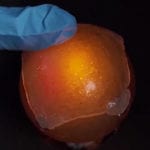 Mysteries
Mysteries  Mysteries
Mysteries  History
History 10 Surprising Stories About the Texas Rangers
 Humans
Humans 10 Philosophers Who Were Driven Mad by Their Own Theories
 Miscellaneous
Miscellaneous 10 Video-Game-Worthy Weapons and Armors from History
 Weird Stuff
Weird Stuff 10 Psychics Who Accurately Predicted Wartime Events
 The Arts
The Arts 10 Pieces of Art Inspired by a Broken Heart
 Health
Health 10 Science Fiction-Sounding New Medical Treatments
 History
History 10 Surprising Facts About the Father of Submarine Warfare
 Space
Space Ten Astonishing New Insights into Alien Worlds
 Weird Stuff
Weird Stuff 10 Bizarre Summer Solstice Rituals Still Practiced Today
 Mysteries
Mysteries Top 10 Haunting Facts About the Ghost Ship MV Alta
 History
History 10 Surprising Stories About the Texas Rangers
 Humans
Humans 10 Philosophers Who Were Driven Mad by Their Own Theories
Who's Behind Listverse?

Jamie Frater
Head Editor
Jamie founded Listverse due to an insatiable desire to share fascinating, obscure, and bizarre facts. He has been a guest speaker on numerous national radio and television stations and is a five time published author.
More About Us Miscellaneous
Miscellaneous 10 Video-Game-Worthy Weapons and Armors from History
 Weird Stuff
Weird Stuff 10 Psychics Who Accurately Predicted Wartime Events
 The Arts
The Arts 10 Pieces of Art Inspired by a Broken Heart
 Health
Health 10 Science Fiction-Sounding New Medical Treatments
 History
History 10 Surprising Facts About the Father of Submarine Warfare
 Space
Space Ten Astonishing New Insights into Alien Worlds
 Weird Stuff
Weird Stuff 10 Bizarre Summer Solstice Rituals Still Practiced Today
10 Ancient Technologies We Cannot Recreate Today
History slowly and inevitably decays into mystery. As time passes, we lose knowledge and culture to the invisible realm of the forgotten. The more we dig into history and the more we uncover, the more we realize how much we’ve already lost. Much of the evidence for lost ancient technologies and artifacts suggest that our development as a species may not have been strictly linear.
Early civilizations have repeatedly made discoveries and invented techniques that we still can’t quite reproduce, even with all of our modern technology and insight. This list is dedicated to those ancient wonders and highlights ten of the most surprising, ingenious, and fascinating ancient technologies that remain a mystery.
Related: Top 10 Ancient Constructions With Fascinating Tales And Riddles
10 Greek Fire
Greek Fire is an interesting historical technology in that it sounds fantastic, was completely real, and its composition remains a mystery. This ancient weapon was used primarily by the Byzantine Empire between the 600s and 1200s. It consisted of a pipe mounted to Byzantine ships that sprayed a thick, gel-like fire at enemy vehicles. Dozens of relatively reliable sources attest to its existence, but by the 1300s, all accounts of the weapon stopped.
It’s thought that the recipe was lost due to either the empire’s gradual decay or its loss of territory with the necessary ingredients, but either way, Greek Fire fell into mystery. Due to its ability to keep burning on the surface of water and the difficulty in putting it out, most experts believe it was at least somewhat similar to modern napalm.
9 Lycurgus Cup
If there were nothing else to it, the fourth-century Lycurgus cup would be an amazing piece just for the ornate decorative glass cage surrounding it, depicting a mythical scene of King Lycurgus. But beyond surface-level beauty, the Lycurgus cup’s core composition is a genuine ancient wonder and leaves today’s experts scratching their heads.
The cup’s glass is dichroic; it appears red when lit from behind and green when lit from the front. There are very few other examples of this effect from the time period and none which are as large, complete, or striking in their color differential. That’s because the process used to create that dichroic effect requires the precise and measured manipulation of gold and silver nanoparticles. Nanotechnology was likely unknown to the Romans, as we only discovered it in the 1970s, so archaeologists are left with the unsatisfying assumption that the dichroism was likely formed accidentally.
8 DaVinci’s Tank
Leonardo da Vinci was perhaps the single smartest human being ever to live on this green earth, which is why it’s so baffling that he designed an armored war vehicle that didn’t work.
Dubbed “Leonardo’s fighting vehicle,” the heavy proto-tank had a conical shell of armor and looked a lot like a giant turtle. Perhaps too like a turtle, as the vehicle’s schematics suggest it would be too heavy and too slow to be effective in any form of combat. Further adding to the mystery, the gears necessary to power its movement were designed in reverse order. This mistake seems unlikely for the brilliant engineer da Vinci, and some historians think he deliberately sabotaged the vehicle’s design to prevent its use.
7 Oxford Electric Bell
Unlike most entries on this list, scientists could probably figure out how the Oxford Electric Bell works tomorrow if they tried. The problem is that this would entail ending the Bell’s 181-year experiment, which otherwise shows no signs of stopping.
The Bell has been ringing since 1840. Built by the London firm Watkins and Hill, two dry pile batteries power this swinging instrument. You would usually expect such primitive batteries to die long ago, but the unique composition of the Bell’s batteries has kept it going strong. Though scientists are desperate to figure that composition out, the Bell is one of the oldest ongoing experiments in the world, and ending it prematurely is too great a cost.
6 Nepenthe
Nepenthe was a drug used by the Ancient Greeks and Egyptians to produce happiness and ease pain. Both history and mythology from that era reference the drug by name, a name which translates to “that which chases away sorrow,” or more literally, “anti-sorrow.” It’s clear that Nepenthe was some form of anti-depressant or opioid, but historians have no idea which one and if we even know about it.
Theories abound on the exact nature of Nepenthe. They include wormwood, hemp, and opium, which is the most common. However, the issue with that hypothesis is that opium was known to the Greeks already and used all throughout the ancient world; they even depicted their gods of sleep holding poppies. Why, then, would they create a new term for a common drug and only use it in select sources?
5 The Antikythera Mechanism
It would be hard to write an article on mysterious, surprisingly advanced ancient technology without mentioning the Antikythera Mechanism. Found in a shipwreck off the coast of the Greek island Antikythera, scientists have assembled and inferred enough pieces of the mechanism to reveal its use. They’re fairly certain that the mechanism is an orrery or a mechanical solar system model. The mystery is that it was made in the first or second century, and clockwork that sophisticated had never been seen in history until 1200 years later.
The mechanism had at least 37 intermeshing gears, and all its moving pieces combined to predict the movements of celestial bodies fairly accurately. Though other similar devices were mentioned in various texts from that era, none have ever been found with anything but a small fraction of the Antikythera Mechanism’s mechanical complexity.
4 The Rocks at Sacsayhuaman
Sacsayhuaman is an Incan fort from the 1400s, located just outside of Cusco, Peru. What makes the site so impressive and so enigmatic are its walls, which are built from stacked stones that each weigh roughly 100-120 tons. On top of that, the massive stones have smooth, polished finishes and fit neatly together, suggesting they were melted and re-hardened inside a type of kiln. No kiln could ever be that big, especially not 600 years ago.
Researchers are divided as to how the stones were molded. Some suggest complex systems of mirrors and glass to harness and magnify solar energy, but no record of such a system exists. Others have suggested that the walls were originally more jagged until natural fires partially melted the stones together. However, experiments have shown that regular, non-insulated fire could not get hot enough to affect the stone.
3 The Pyramids of Giza
Like the Antikythera Mechanism, the Pyramids of Giza are a necessity when talking about ancient technological mysteries. The Great Pyramids have perplexed the world for thousands of years, and in all that time, no one has ever been able to conclusively determine how they were created.
The structures are made from millions of stone blocks, all weighing tens or hundreds of tons apiece. In trying to explain how the ancient Egyptians moved, shaped, and stacked these stones, scientists have developed dozens of theories. So many theories, in fact, that they are grouped into categories for easier comparison. There are the straight ramp theories, the zigzag ramp theories, internal ramp theories, water-based theories, concrete theories, and even some that posit unusually complex, large machinery whose designs were lost to time.
2 Damascus Steel
Damascus steel was a metal used in the Middle East in the Middle Ages with a legendary reputation for hardness and the ability to be formed into the sharpest of edges. Despite the relatively wide proliferation of the blades in the ancient world and despite their roughly 1,100 years of manufacture, the formula for creating the blades has been lost to time.
Many theories have attempted to address the technique’s gradual demise, usually focused on the secrecy of the process and the increasing difficulty in procuring the necessary ores. Likewise, many modern sword-smiths have attempted to recreate the blades’ unique properties to varying levels of success. None have considered their results perfect yet.
1 Stradivari
Topping the list are the most famous musical instruments in history—the few string instruments confirmed to have been made by master craftsman Antonio Stradivari (and family) in the 1600s and 1700s. Stradivari are known for their peerless sound quality, and the vast majority of the best players in the world use them as their primary instruments. Around 600 of them survive to the present day, with more and more succumbing to the perils of time each year and the formula for reproducing them lost.
The instruments have been the subject of intense scrutiny for centuries, as various researchers attempt to either explain their unique qualities or debunk them entirely. There is still intense debate over whether or not the instruments are genuinely superior or just the products of learned bias. Recent studies, using more sophisticated technology than previously available, such as X-rays and CT scans, have indeed found some unusual properties in the finest of the Stradivari. Most commonly, it seems that their wood is unusually dense, which may contribute to a superior resonance.








